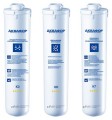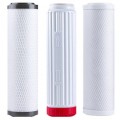Size
Cartridges for flow and reverse osmosis systems can belong to one of two classes: SL (Slim Line) for small filters where compact size and ease of cartridge replacement are important, and BB (Big Blue) for large systems where high flow Rate and processing ability are required significant volumes of water. At the same time, the standard size is usually indicated in height and diameter. These figures are expressed in inches.
First of all, the size allows you to assess the compatibility of the cartridge with a specific filter. Here we note that filter housings are available in standard sizes, and many cartridges are quite compatible with “non-native” filters due to the same size. In addition, the larger the filter element (other things being equal), the larger its effective area and the higher the throughput.
Cartridges are often marked
5SL (5"x2.5"),
10SL (10"x2.5"),
20SL (20"x2.5"),
10BB (10"x4.5"),
20BB (20"x4. 5").
The size of membranes for reverse osmosis systems is also expressed in inches. The most widely used options are
12”x1.8”,
12”x2”,
12”x3”,
13”x3”.
Standard sizes also have
linear cartridges...in the form of modules made of white or transparent plastic. However, they may differ in the types of connections to the pipes (¼” internal thread, quick-release adapter to ¼” tube, ¼” adapter rod). And cartridges for some water treatment systems are produced in proprietary sizes and are suitable only for specific filters.Pollution clipping
The smallest particle size that the cartridge is capable of retaining; smaller contaminants will be able to penetrate through it. Accordingly, the
smaller the number in this point, the finer the filtering provided by the cartridge. On the other hand, increasing the filtration thoroughness inevitably reduces the performance, other things being equal. So the choice of cartridge is often based on a compromise between thoroughness of cleaning and throughput.
Also note that the choice depends on the purification stage at which the cartridge is planned to be installed. So, at the initial stage, coarse cleaning is used, with clipping impurities at the level of 25 microns or more. Filter elements with an index from 25 to 0.3 microns are classified as fine filters, and lower values are typical for ultra-fine elements, in particular, for osmotic membranes (see "Application").
Resource
The resource of a cartridge is the amount of water that it can effectively pass through itself and clean without loss of working qualities. For reusable models (see below), the resource between cleanings/regenerations is usually indicated.
This parameter allows you to estimate
how long the cartridge will last and how often it will need to be changed or cleaned. There are formulas that allow you to calculate the approximate water consumption depending on the number of people in the family and other factors; these formulas can be found in special sources. However, manufacturers themselves often make approximate calculations and indicate the frequency of replacement in the documents for a filter or cartridge: for example, “when used in a family of 3 people, change every month”. In fact, it is more convenient to use these recommendations.
Filtration and purification
Types of filtration provided by the cartridge. This parameter takes into account both the types of pollution that the product is able to cope with, and some features of its operation.
—
Mechanical(impurities, sand). Purification from mechanical impurities — insoluble particles larger than a certain size (see "Pollution clipping"). The simplest cleaning method that can be achieved with relatively simple and inexpensive filter elements.
—
Carbon(active chlorine, smell, taste). Purification through the use of
activated carbon or other similar sorbent. Such a sorbent absorbs foreign substances dissolved in water, providing cleaning at the chemical level.
—
Colloidal iron (rust). Purification of colloidal iron — particles suspended in water, which consist of insoluble iron compounds and give the water a characteristic "rusty" shade with a corresponding taste and smell. Some of this iron can be removed from the water by mechanical filtration, but additional chemical cleaning methods can be provided to increase efficiency. Therefore, this type of filtering is rendered separately.
—
Hardness salts (limescale)). Removal of calcium and magnesium salts, which make water hard and lead to the formation of scale on heating elements (in particular, heating elements of washing
...machines and dishwashers). Also note that excessive water hardness reduces the effectiveness of detergents. To remove hardness salts, different methods can be used, depending on the composition of the cartridge (see the relevant paragraph). So, ion-exchange resins take calcium and magnesium ions from water, replacing them with sodium ions; polyphosphate crystals form soluble compounds with hardness salts that do not limescale; and osmotic membranes (see "Application") filter out salts at the molecular level.
— Heavy metal ions. Removal from water of ions of various heavy metals that are harmful to humans — mercury, cadmium, plumbum, etc. Such purification can be carried out both chemically (reagent) and osmotically (see "Application").
— UV cleaning (bacteria). Purification of water from pathogenic bacteria, fungi and other microorganisms, carried out by exposure to ultraviolet radiation. Such radiation is detrimental to microorganisms, while it does not affect the chemical properties of water and does not affect its quality.
— Mineralization. Saturation of filtered water with minerals useful for the human body. This function is often provided in reverse osmosis systems (see "Application"): osmotic purification removes not only harmful, but also useful impurities from the water, as a result, the water turns out to be "dead", which does not carry any benefit (and it may even taste unpleasant). Mineralization allows you to compensate for this moment.
— Improving taste. This item includes cartridges installed after post-filters in reverse osmosis systems. These can be carbon, bio-ceramic and other similar filter elements designed to saturate the taste of already purified water. Advanced implementations of such cartridges make it possible to obtain water that is as close as possible to natural water in its structure and taste.
— Nitrates. Purification of water from nitrates — salts of nitric acid. Nitrates are widely used as fertilizers; most of them are processed by plants into harmless compounds, but unused residues can enter the water, and such substances are harmful to the human body. Purification can be carried out both by reverse osmosis (see "Purpose"), and chemically — due to substances that connect nitrates and do not allow them to pass the filter.
— Pesticides. Pesticides are toxic chemicals used to combat harmful flora and fauna — weeds, insects, rodents, etc. Most of these compounds are also harmful to humans. Removal of pesticides can be provided by adsorption (absorbing) filters or reverse osmosis systems (see "Application").
— Petroleum products. Oil and various substances obtained from it (gasoline, kerosene, diesel fuel, fuel oil, etc.). Poisonous when taken orally. Oil products do not dissolve in water, but may be present as a suspension or film on the surface. They are removed mainly by adsorption or reverse osmosis (see "Application").
